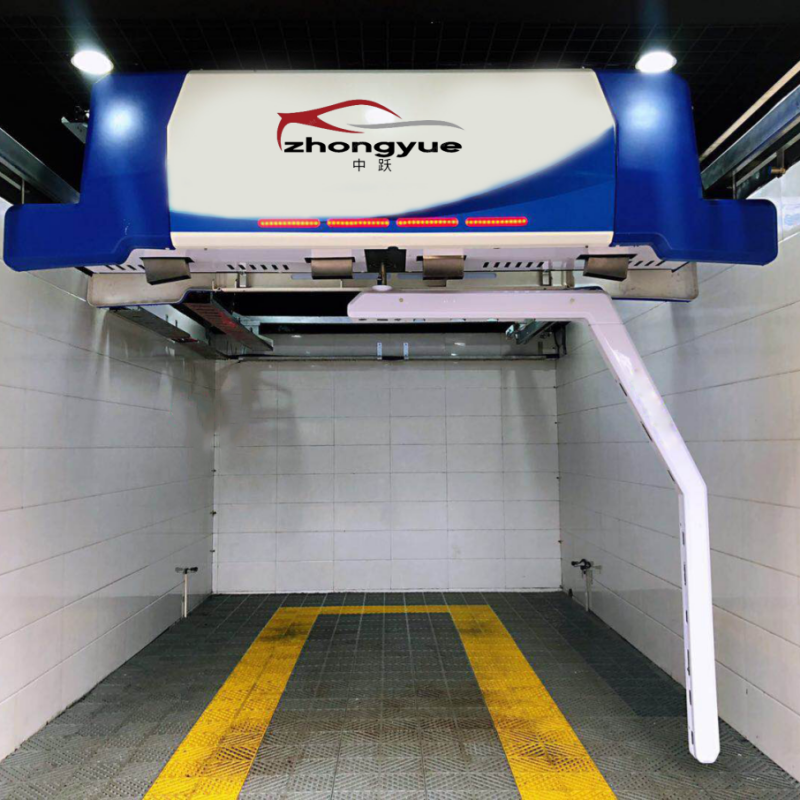As the number of cars continues to increase, the demand for car washing is also growing. Fully automatic car washing equipment has gradually become the mainstream choice in the car washing industry with its convenience and labor-saving characteristics. As a manufacturer of fully automatic car washing equipment, our company now analyzes the energy consumption of fully automatic car washing equipment through the types of car washing equipment, energy consumption composition, influencing factors and energy-saving measures.
1. Types and energy consumption characteristics of fully automatic car washing equipment
Fully automatic car washing equipment is mainly divided into two categories: tunnel car washing machine and reciprocating car washing machine. Its energy consumption varies depending on the type of equipment and working principle.
The tunnel car washing machine adopts assembly line operation. The vehicle is driven by a conveyor belt and goes through the processes of washing, waxing, air drying, etc. in sequence. Because the equipment needs to run continuously for a long time, its energy consumption is relatively high, especially the core components such as water pumps, fans, and conveyor belts consume a lot of electricity.
Reciprocating car washing machine
The reciprocating car washing machine uses fixed equipment. After the vehicle is parked in place, the equipment moves to complete the cleaning process. Since the equipment only runs when washing the car and does not need to be kept running for a long time, the energy consumption is relatively low.
2. Energy consumption composition of fully automatic car washing equipment
The energy consumption of fully automatic car washing equipment mainly comes from the following aspects:
Power consumption
Electricity is the main energy source of fully automatic car washing equipment, which is mainly used to drive core components such as water pumps, fans, conveyor belts, and motors. Among them, the energy consumption of water pumps accounts for a high proportion because high-pressure water flow is required to complete the cleaning task; the energy consumption of fans is second, mainly used for the air drying process of vehicles.
Water resource consumption
Although water resources do not belong to the traditional sense of "energy consumption", their usage is closely related to the energy consumption of equipment. The water circulation system can reduce water resource consumption and reduce the workload of water pumps, thereby indirectly reducing energy consumption.
Chemical detergent consumption
Fully automatic car washing equipment usually requires the use of chemical agents such as detergents and wax water. Although the consumption of these agents is not directly reflected in energy consumption, their production, transportation and processing processes will also cause a certain energy burden on the environment.
Equipment maintenance energy consumption
Daily maintenance and care of equipment also requires a certain amount of energy consumption, such as replacing lubricants and parts.
3. Factors affecting the energy consumption of fully automatic car washing equipment
Equipment technology level
Equipment with a higher level of technology usually adopts energy-saving design, such as water pumps, variable frequency motors, intelligent control systems, etc., which can effectively reduce energy consumption. However, due to backward technology, old equipment often has high energy consumption.
Workload
The workload of the equipment directly affects its energy consumption. For example, when washing cars continuously during peak hours, the energy consumption of the equipment will increase significantly; while during non-peak hours, the energy consumption of the equipment is relatively low.
Water circulation system
The efficiency of the water circulation system has an important impact on energy consumption. The water circulation system can reduce water resource consumption and reduce the workload of the water pump, thereby reducing energy consumption.
Environmental factors
External factors such as ambient temperature and water quality can also affect the energy consumption of the equipment. For example, in winter, due to the low water temperature, the equipment may require additional heating, thereby increasing energy consumption.
Operation specifications
The operator's standardized operation also has a certain impact on energy consumption. For example, reasonable adjustment of equipment parameters and timely maintenance of equipment can reduce energy consumption.
IV. Energy-saving measures for fully automatic car washing equipment
Use energy-saving technology
Introduce energy-saving technologies such as water pumps and variable frequency motors,

Post time: May-17-2025